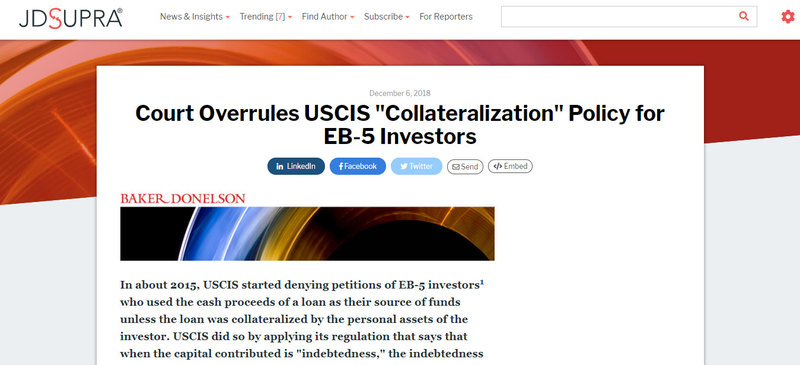Court Overrules USCIS "Collateralization" Policy for EB-5 Investors LinkedIn
In about 2015, USCIS started denying petitions of EB-5 investors1who used the cash proceeds of a loan as their source of funds unless the loan was collateralized by the personal assets of the investor. USCIS did so by applying its regulation that says that when the capital contributed is "indebtedness," the indebtedness must be collateralized by the investor's personal assets.
On November 30, 2018, in Zhang v. USCIS, a federal judge in the District of Columbia ruled that the regulation only applies to situations where the investor actually invests less than the necessary $500,000 in cash or other assets and makes up the rest with a promissory note. The judge distinguished the use of loan proceeds that are contributed to the investment enterprise as cash so that the regulation clearly does not apply. The judge said, therefore, that the denials were "arbitrary and capricious" and that, because the USCIS policy was a "legislative rule" to change the plain meaning of an existing regulation, the policy could not be imposed without the agency going through a "notice and comment" rulemaking process.
The judge applied the decision to the class of investors who invested cash from loan proceeds and had been denied their I-526 petition on the sole basis that the loan was not collateralized by the investor's personal assets. If USCIS appeals the denial to the Court of Appeals, the court's decision probably will be stayed pending appeal. Without appeal, the decision will retroactively reopen all I-526 denials issued solely on the collateralization requirement, regardless of how long ago the denial was issued.
The judge reversed the denials but did not grant the petitions, instead sending them back to USCIS for decision in light of the judge's decision, based on longstanding precedent because "there may be sensitive issues lurking that are beyond the ken of the court." USCIS could find other reasons to deny. The judge recognized that his decision does not stop USCIS from reviewing whether the loan proceeds were "legally obtained," which is always an EB-5 requirement, and USCIS could look into whether the investor made misrepresentations to the lender about the nature of the loan.
The judge also noted that USCIS rules prohibit the use of proceeds of a loan that is collateralized by the investment itself. USCIS might also require evidence about where the lender obtained the funds, especially if the lender was not a chartered and regulated bank, just as USCIS currently requires "currency swappers" who have facilitated getting money out of certain countries to show the legitimate source of the swapped funds.
1 Under the EB-5 Program, a foreign national can qualify for U.S. permanent residence by investing $1 million (or $500,000 in a "Targeted Employment Area") in a "new commercial enterprise" that uses the capital to create ten new full-time jobs for U.S. workers.
https://www.jdsupra.com/legalnews/court-overrules-uscis-collateralization-98732/
Mentions
Litigation Cases
States
- New York
Videos





Subscribe for News
Site Digest
Join Professionals on EB5Projects.com →
Securities Disclaimer
This website is for informational purposes only and does not constitute an offer or solicitation to sell shares or securities. Any such offer or solicitation will be made only by means of an investment's confidential Offering Memorandum and in accordance with the terms of all applicable securities and other laws. This website does not constitute or form part of, and should not be construed as, any offer for sale or subscription of, or any invitation to offer to buy or subscribe for, any securities, nor should it or any part of it form the basis of, or be relied on in any connection with, any contract or commitment whatsoever. EB5Projects.com LLC and its affiliates expressly disclaim any and all responsibility for any direct or consequential loss or damage of any kind whatsoever arising directly or indirectly from: (i) reliance on any information contained in the website, (ii) any error, omission or inaccuracy in any such information or (iii) any action resulting therefrom.



